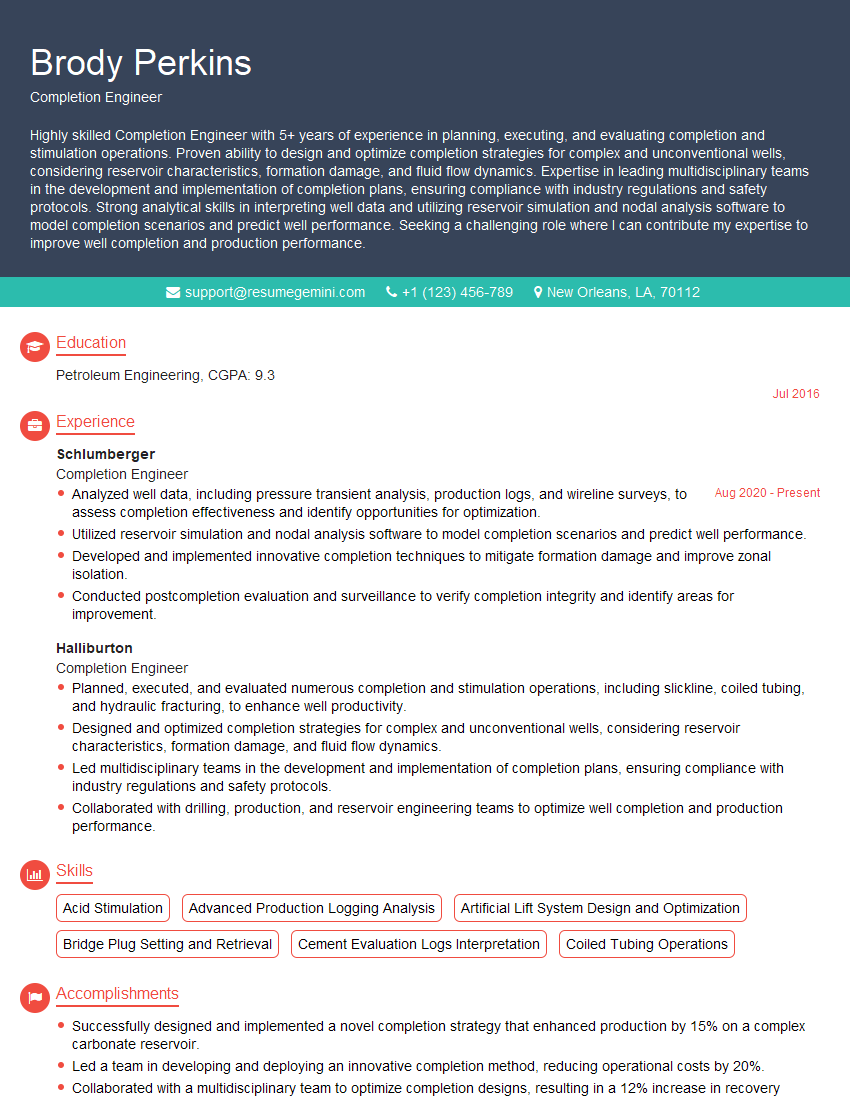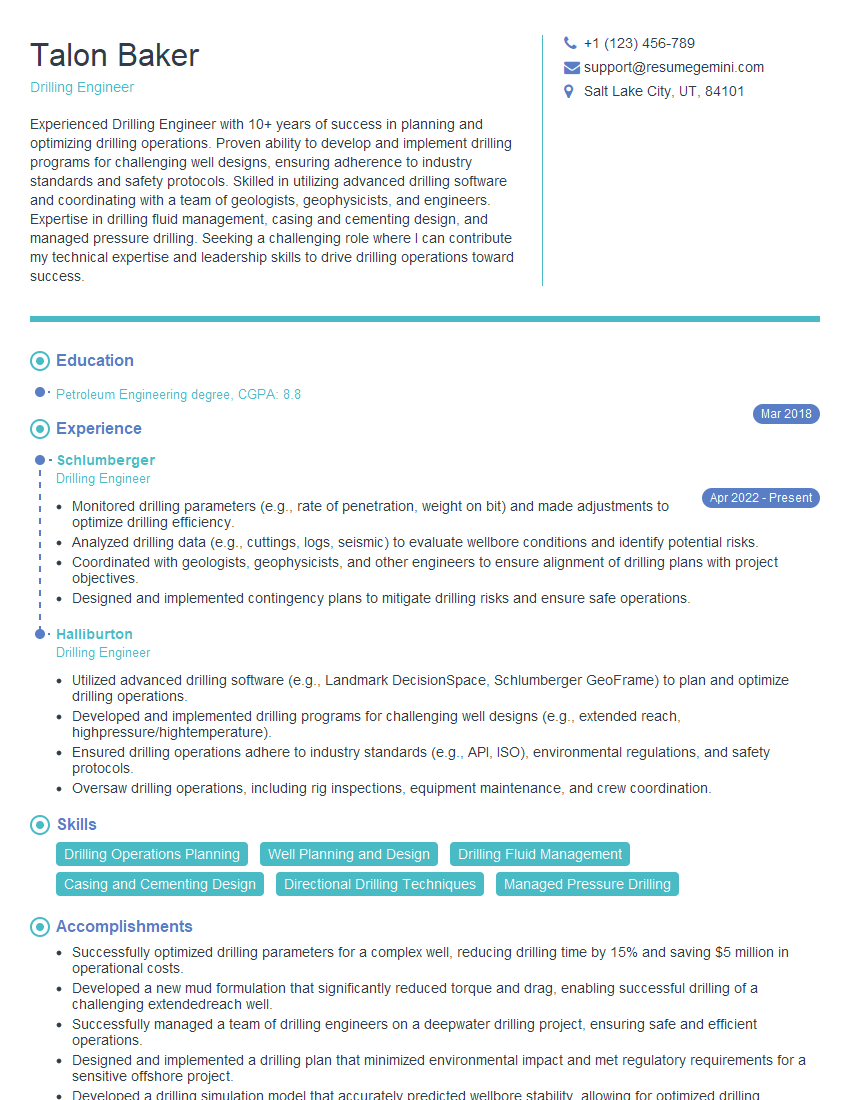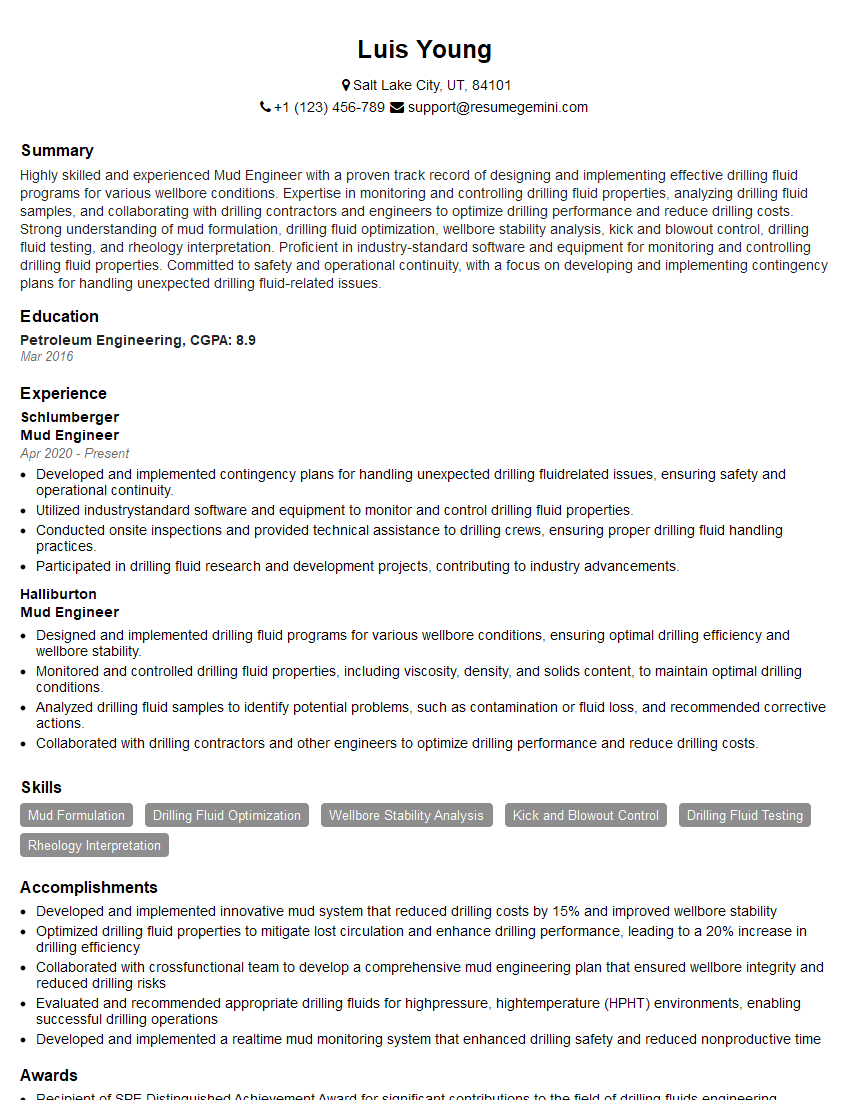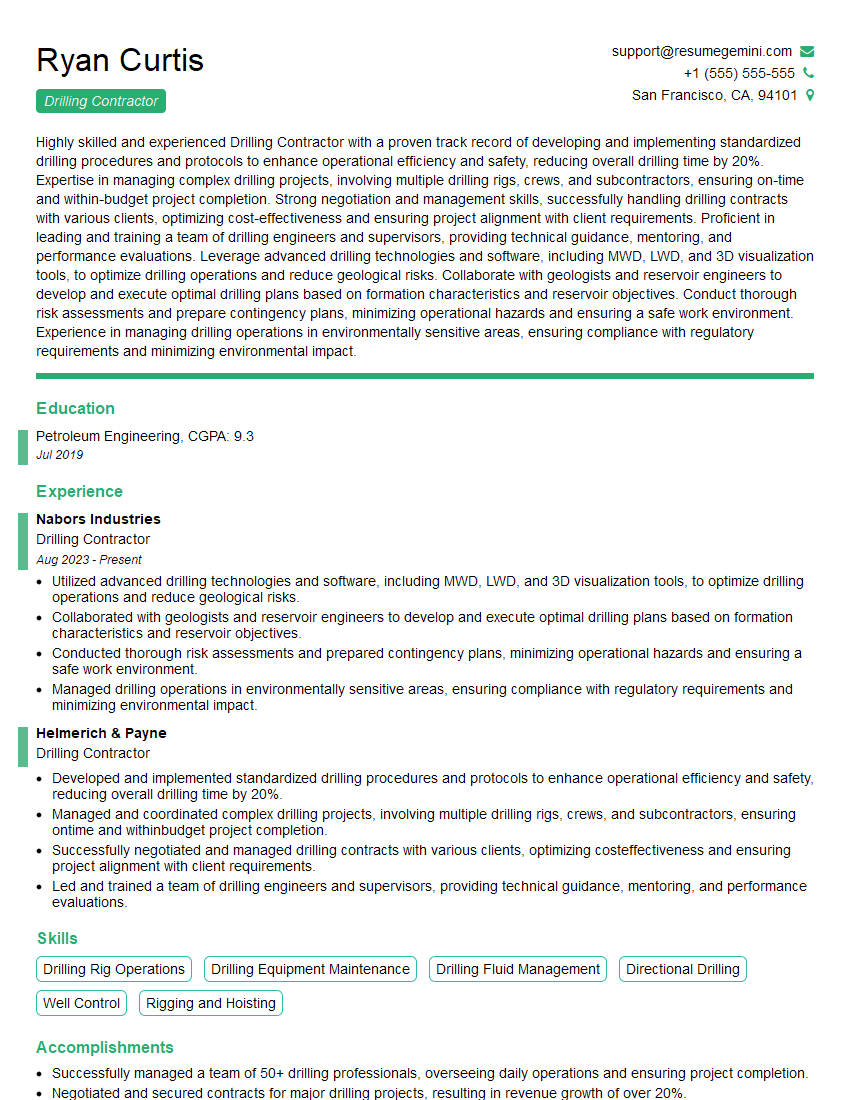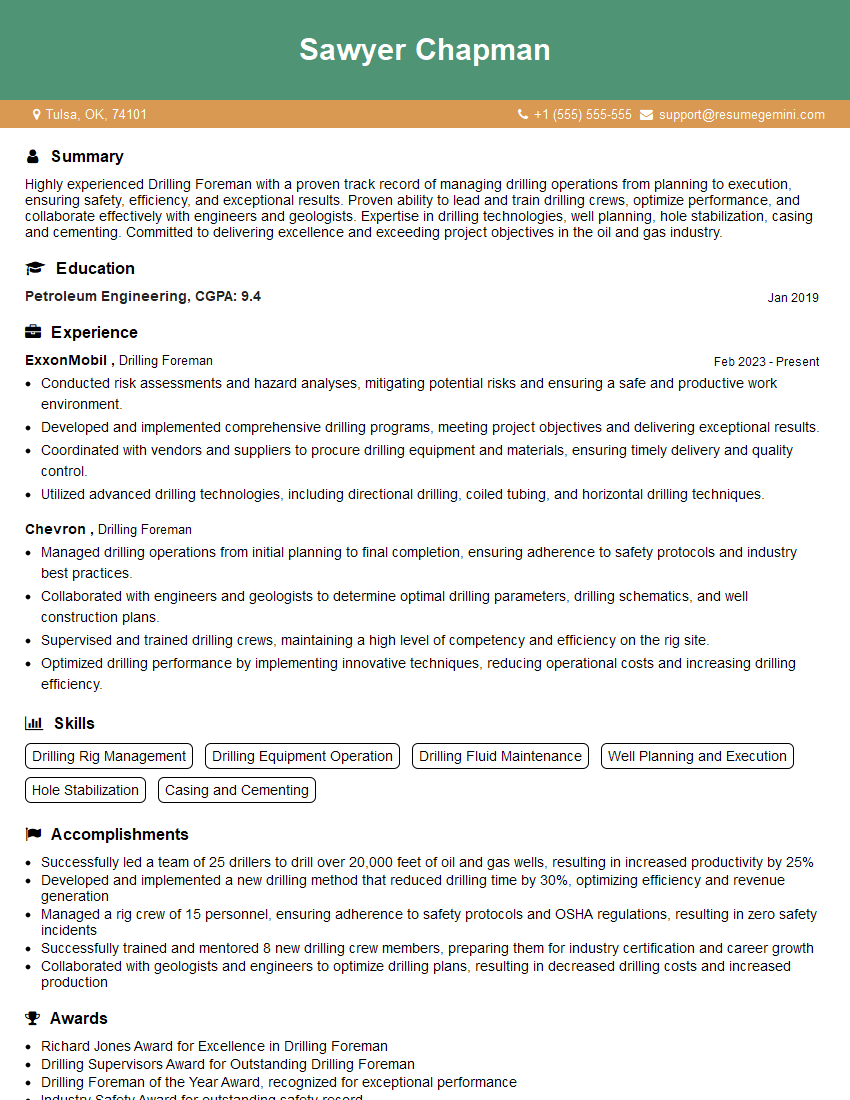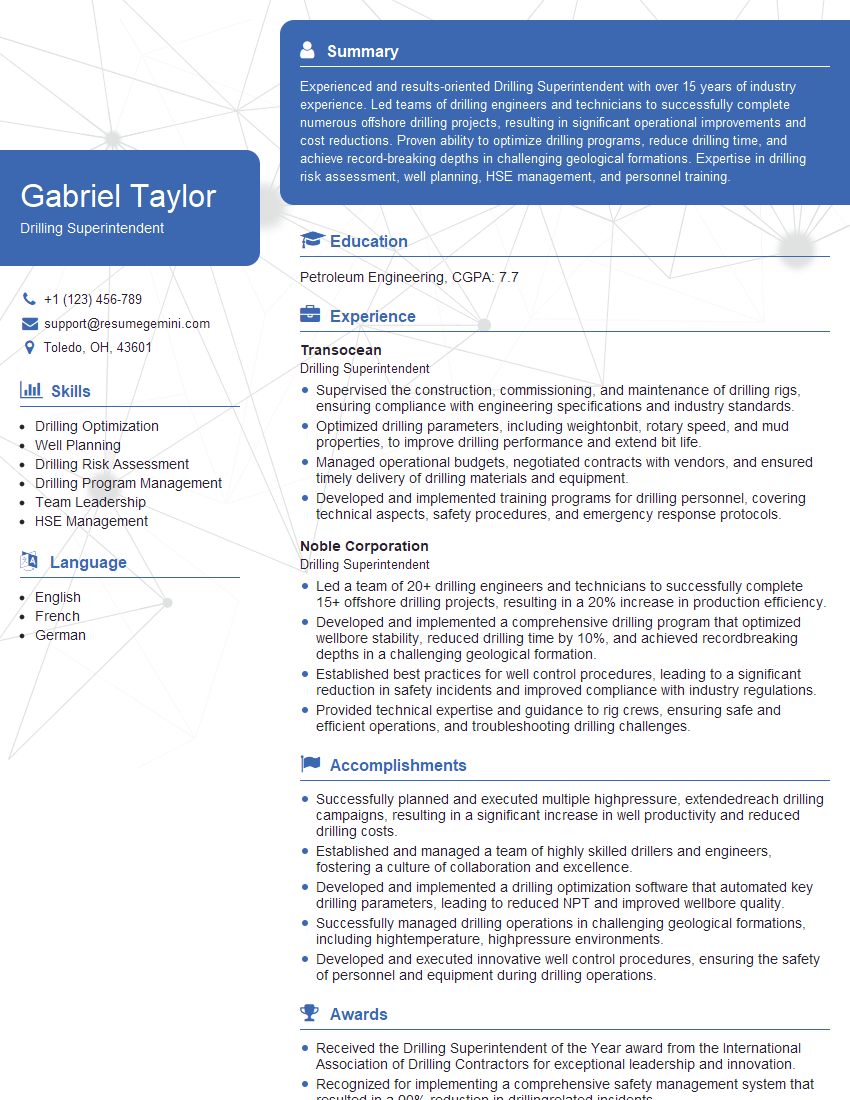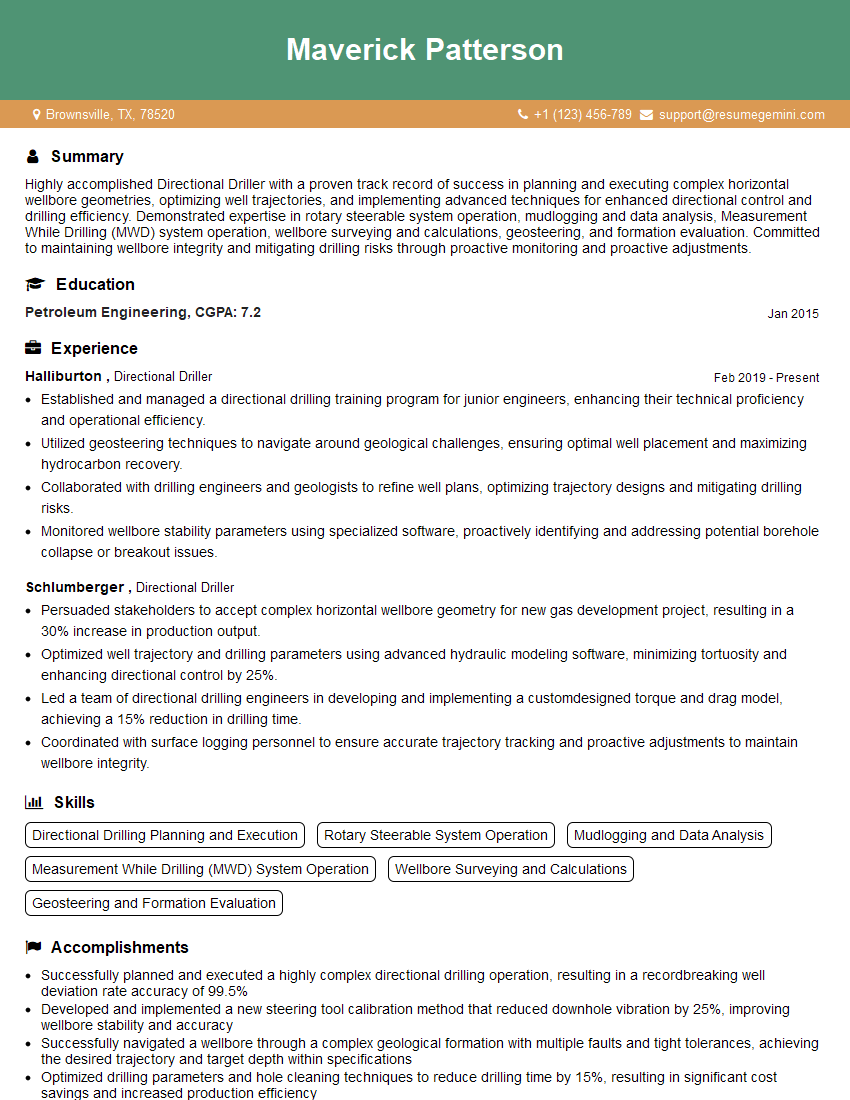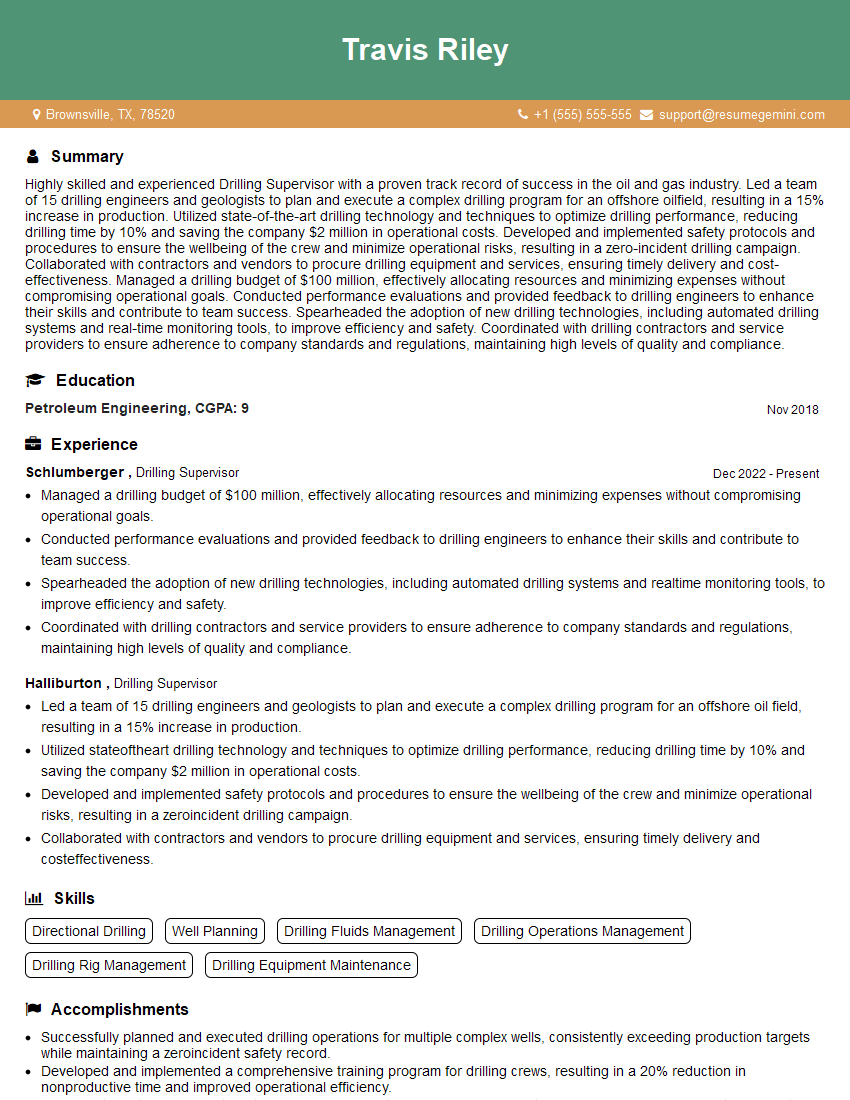The thought of an interview can be nerve-wracking, but the right preparation can make all the difference. Explore this comprehensive guide to Drilling Equipment Expertise interview questions and gain the confidence you need to showcase your abilities and secure the role.
Questions Asked in Drilling Equipment Expertise Interview
Q 1. Describe your experience with different types of drilling rigs (e.g., land rigs, jack-up rigs, semisubmersibles).
My experience encompasses a wide range of drilling rigs, each suited to different environments and well types. Land rigs are the workhorses of onshore operations, characterized by their robust construction and adaptability to various terrains. I’ve worked extensively with both conventional and modern land rigs, including those equipped with automated drilling systems. Jack-up rigs, with their legs that rest on the seabed, are ideal for shallow-water offshore drilling. I’ve been involved in projects using various jack-up designs, from older cantilever rigs to newer, more advanced self-elevating platforms. Finally, I have significant experience with semisubmersible rigs, which utilize buoyancy and ballast systems to maintain stability in deeper waters. These are complex systems requiring detailed knowledge of their dynamics and operational limits; I’ve been directly involved in the planning and execution of multiple deepwater drilling campaigns using these rigs. The key differences lie in their mobility, water depth capabilities, and overall cost effectiveness for specific projects.
Q 2. Explain the process of selecting appropriate drilling mud for a specific well.
Selecting the right drilling mud is crucial for wellbore stability and efficient drilling. It’s not a one-size-fits-all process. We begin by analyzing the geological formations we expect to encounter. Factors like shale type, pore pressure, and temperature significantly influence mud properties. For instance, in shale formations prone to swelling, a mud with high inhibition properties is necessary to prevent wellbore instability. Similarly, high-pressure zones might require a heavier mud density to control formation pressure. The mud’s rheological properties – its viscosity and yield point – are optimized to effectively carry cuttings to the surface and minimize friction on the drill string. We also consider environmental regulations and potential effects on the formation, especially regarding water-based vs. oil-based muds. The selection process involves a detailed review of well logs, formation testing data, and expert judgment. It often involves laboratory testing of various mud formulations to identify the best match for the specific well conditions. We continuously monitor and adjust mud properties throughout the drilling process to maintain optimal performance and wellbore integrity.
Q 3. What are the key components of a top drive system and how does it function?
A top drive system is a crucial advancement in drilling technology, replacing the traditional rotary table. Its key components include a powerful electric motor, a gear reduction system, a rotating head, and a power swivel. The electric motor drives the gear reduction system, which in turn rotates the top drive head. This head is connected to the drill string, enabling precise control over rotational speed and torque. The power swivel allows for continuous circulation of drilling mud while the drill string is rotating. The advantages are significant: increased speed and efficiency, improved control over directional drilling, and reduced rig floor space. Imagine trying to control a massive drill string with a traditional rotary table; the top drive offers superior precision and responsiveness, especially in complex well designs.
Q 4. How do you troubleshoot a stuck pipe situation?
A stuck pipe situation is a major challenge in drilling, potentially leading to significant non-productive time and cost overruns. Troubleshooting starts with careful assessment of the situation – is it a differential pressure sticking, a mechanical sticking, or a combination? We gather data from the weight on bit, torque readings, and mud pressure. We then systematically try different techniques. For differential pressure sticking, we might attempt to equalize pressures by adjusting mud weight or circulating the mud. For mechanical sticking, we might use various techniques like jarring, rotating, or applying weight to try and free the pipe. More aggressive methods, like using specialized tools like fishing tools or milling the pipe, might be necessary in severe cases. Throughout the process, detailed logging of all operations is crucial for understanding the causes of sticking and developing effective mitigation strategies. Prevention is key – careful mud management, accurate well planning, and proactive monitoring can significantly reduce the occurrence of stuck pipe incidents.
Q 5. Describe your experience with directional drilling techniques and tools.
Directional drilling allows us to deviate from a vertical path and reach target zones not directly beneath the rig. I have extensive experience with various directional drilling techniques and tools. This includes using mud motors, positive displacement motors, and steerable drilling systems. These tools use various mechanisms to deflect the drill string from its initial path. For example, mud motors use the flow of drilling mud to create rotational torque, enabling directional drilling in complex formations. Steerable systems provide more precise control over the wellbore trajectory, allowing for the creation of complex well paths. My experience includes planning and executing multiple horizontal wells and multilateral wells, requiring detailed knowledge of surveying tools and software, and the ability to interpret and adjust drilling parameters in real-time to achieve the desired well path. The application of directional drilling opens up access to resources that would be otherwise inaccessible using vertical drilling techniques.
Q 6. What safety procedures are essential when operating drilling equipment?
Safety is paramount in drilling operations. We adhere to strict procedures at all times. These include regular safety meetings, thorough risk assessments before commencing any operation, and stringent adherence to the company’s safety protocols and regulatory guidelines. Proper use of personal protective equipment (PPE), including hard hats, safety glasses, and hearing protection, is mandatory. Emergency response plans are developed and practiced regularly to ensure a coordinated response in case of an incident. Lockout/Tagout procedures are rigorously followed during maintenance and repairs to prevent accidental equipment activation. We emphasize a safety-conscious culture, where every employee is responsible for their own safety and the safety of their colleagues. Proactive identification and mitigation of hazards are key aspects of our safety approach.
Q 7. Explain the function of a blowout preventer (BOP) and its various components.
The blowout preventer (BOP) is a critical safety device designed to prevent uncontrolled flow of hydrocarbons from the wellbore. It’s essentially a large valve system that can quickly seal the well in case of a blowout. The BOP stack typically consists of several components, including annular preventers, ram preventers (with various types of rams: blind, shear, and pipe rams), and a control system. Annular preventers seal around the entire drill string, while ram preventers use individual rams to seal against the drill pipe or the wellbore itself. The control system allows for remote activation of the BOP in case of an emergency. Imagine it as a multi-layered safety valve protecting against a catastrophic well failure. Regular inspection and testing of the BOP are crucial to ensure its reliability and readiness in emergency situations. The BOP is a crucial component of well control and a cornerstone of drilling safety.
Q 8. How do you manage wellbore instability issues during drilling operations?
Wellbore instability is a major concern in drilling, leading to stuck pipe, formation collapse, and increased costs. Managing it effectively involves a multi-pronged approach focusing on understanding the formation and employing appropriate mitigation strategies.
Firstly, thorough pre-drill geological analysis is crucial. This helps identify potential unstable zones, such as shale formations prone to swelling or unconsolidated sands susceptible to collapse. Based on this analysis, we can tailor our drilling fluid properties.
- Mud Weight Optimization: Maintaining an optimal mud weight is paramount. Too low, and the formation may collapse; too high, and we risk fracturing the formation, leading to lost circulation. This is a delicate balance often requiring real-time adjustments based on measured pressures and observed drilling indicators.
- Mud Chemistry: We might incorporate inhibitors to prevent shale swelling, polymers to enhance viscosity and reduce friction, or weighting agents to increase the mud density. The specific mud chemistry depends heavily on the formation characteristics. For example, in a shale prone to swelling, we might use potassium chloride-based muds instead of sodium chloride-based muds.
- Drilling Parameters: Careful control of drilling parameters like rate of penetration (ROP), weight on bit (WOB), and rotary speed is essential. Aggressive drilling can induce fractures, while slow drilling can increase the exposure time to potentially unstable formations.
- Casing and Cementing: Strategically placing casing and cement is crucial to isolate unstable zones. By creating a stable barrier, we prevent formation fluids from entering the wellbore and minimize the risk of wellbore collapse.
For instance, I once worked on a well in a shale gas formation where aggressive drilling resulted in multiple instances of stuck pipe. By switching to a more controlled drilling regime and optimizing the mud system to include shale inhibitors, we were able to drastically reduce the incidents of stuck pipe and complete the well successfully.
Q 9. What is your experience with MWD/LWD tools and data interpretation?
My experience with Measurement While Drilling (MWD) and Logging While Drilling (LWD) tools spans over ten years. I’m proficient in interpreting data from various tools, including gamma ray, resistivity, porosity, and density logs, to make crucial real-time decisions during drilling operations.
MWD tools provide real-time information about the wellbore trajectory, inclination, azimuth, and other drilling parameters. This is critical for directional drilling and ensuring the well is drilled to the planned target. I utilize this data for course corrections and optimize drilling parameters to maximize ROP.
LWD tools measure formation properties while drilling, providing valuable geological information. This data is used to identify potential hydrocarbon zones, evaluate reservoir quality, and guide the drilling process in real-time.
Data interpretation involves carefully examining the trends and anomalies in the logged data. We often use specialized software to analyze the data and create detailed geological models. For example, detecting a sudden change in gamma ray readings might indicate a lithological boundary, while changes in resistivity can help identify a potentially productive reservoir. Experienced interpretation allows us to predict potential drilling challenges and make timely decisions about the well’s design and operational parameters.
In one specific instance, LWD data revealed a previously unmapped fault zone. By identifying this zone in real-time, we were able to adjust the drilling path, preventing a costly and potentially dangerous incident.
Q 10. Describe the process of running casing and cementing a well.
Running casing and cementing is a crucial step in well construction, providing structural support and isolating different zones within the wellbore. The process involves several key steps:
- Preparation: This includes inspecting the casing string for any damage and preparing the wellbore for casing placement. This might involve cleaning and conditioning the wellbore using drilling fluid.
- Running the Casing: The casing string, which is a long, hollow steel pipe, is lowered into the wellbore using a top drive or drilling rig. A downhole assembly is used to guide the casing and ensure proper placement.
- Cementing: Once the casing is at the desired depth, a cement slurry is pumped down the annulus (the space between the casing and the wellbore). The cement displaces the drilling fluid and forms a solid bond with the casing and the formation. The goal is to create a secure barrier that prevents fluid migration.
- Cement Evaluation: After cementing, various techniques such as cement bond logging (CBL) and variable density logging (VDL) are employed to ensure the cement is properly placed and has achieved a good bond with the casing and formation.
Proper casing and cementing is critical for well integrity, preventing fluid leaks, controlling well pressure, and ensuring the long-term sustainability of the well. Failure to properly cement can result in lost circulation, well control issues, and environmental hazards.
I’ve encountered situations where poor cement placement led to annular flow, requiring costly remedial work. This reinforced the importance of rigorous quality control in every stage of casing and cementing operations.
Q 11. Explain different types of drilling bits and their applications.
Drilling bits are the cutting tools at the bottom of the drill string. Various types exist, each suited for different formations and drilling conditions.
- Roller Cone Bits: These bits use rotating cones with teeth or inserts to crush and grind the formation. They are robust and effective in hard, abrasive formations but tend to have lower ROP in softer formations. They are further categorized into types like steel tooth, milled tooth, and insert bits, each optimized for different hardness levels.
- PDC (Polycrystalline Diamond Compact) Bits: These bits use synthetic diamonds embedded in a matrix to cut the formation. They are efficient in a wide range of formations, especially softer rocks, and offer higher ROP compared to roller cone bits in these scenarios. However, they can be more expensive and less effective in extremely hard formations.
- Hybrid Bits: These combine features of both roller cone and PDC bits, offering a balance of durability and efficiency.
The selection of the right bit depends on factors such as the formation type, hardness, abrasiveness, and the desired ROP. For example, in a hard, abrasive sandstone formation, a roller cone bit with tungsten carbide inserts might be the most suitable choice. While in a soft, unconsolidated shale, a PDC bit would be preferred.
Proper bit selection and optimization are critical for efficient drilling operations and minimizing costs. Incorrect bit selection can significantly reduce ROP and increase the overall cost of the well.
Q 12. How do you ensure efficient drilling fluid management?
Efficient drilling fluid management is vital for successful drilling operations. It involves careful planning, monitoring, and control of the drilling fluid system to ensure optimum performance and minimize environmental impact.
Key aspects include:
- Fluid Selection: Choosing the right type and properties of drilling fluid (mud) is essential, based on the formation characteristics and drilling objectives. This may include water-based, oil-based, or synthetic-based muds, each with specific advantages and disadvantages.
- Fluid Treatment: Regular monitoring and treatment of drilling fluid is crucial to maintain desired properties such as viscosity, density, and filtration control. This involves adding various chemicals to control mud properties and prevent issues like shale swelling or formation damage.
- Waste Management: Proper disposal and management of drilling fluid waste are critical to minimize environmental impact. This includes recycling and treating the waste fluid to meet environmental regulations.
- Fluid Loss Control: Preventing excessive fluid loss to the formation is crucial for maintaining wellbore stability and optimizing drilling parameters. This often involves using specialized mud additives that help reduce permeability of the formation.
In one particular instance, we experienced a significant increase in fluid loss while drilling through a highly permeable sandstone. By implementing a robust fluid loss control program and modifying the mud properties by adding special polymers, we successfully stabilized the wellbore and continued drilling without further complications.
Q 13. How do you perform a drill string design for a specific well?
Drill string design is a critical aspect of drilling engineering, requiring a thorough understanding of the well’s planned trajectory, anticipated formations, and operational constraints.
The design process involves several steps:
- Well Plan Review: A thorough review of the well plan, including the planned trajectory, target depth, expected formation properties, and anticipated pressure conditions is essential. This provides the fundamental parameters for the design.
- Load Calculations: This step involves calculating the anticipated loads on the drill string, including weight on bit, axial load, and bending moments. These loads vary with depth and change as the drilling process proceeds.
- Pipe Selection: Based on the load calculations, appropriate drill pipe, drill collars, and other components are selected. Factors to consider include pipe strength, weight, and diameter. The selection process aims to ensure the drill string can withstand the anticipated loads without failure. Different grades of steel and different wall thicknesses are chosen depending on depth and expected stresses.
- BHA (Bottom Hole Assembly) Design: The BHA, which is the assembly of components at the bottom of the drill string, including the drilling bit and stabilizing components, is carefully designed to meet the requirements of the well. The BHA design heavily influences drilling efficiency, stability, and trajectory control.
- Software Simulation: Advanced software tools are used to simulate the drilling process and evaluate the drill string design’s performance under various operating conditions. This process helps optimize the design and minimize the risk of failures.
A well-designed drill string ensures efficient drilling operations, minimizes risks, and reduces the overall cost of the well. An improperly designed string can lead to costly equipment failures, lost time, and potential safety hazards.
Q 14. What are the common causes of equipment failures in drilling operations?
Equipment failures in drilling operations can have significant consequences, leading to delays, increased costs, and potential safety hazards. Common causes include:
- Fatigue and Wear: Repeated cyclic loading during drilling leads to fatigue and wear of components. This is especially prevalent in high-stress areas like drill collars and drill pipe connections. Regular inspections and preventative maintenance are essential to mitigate this.
- Corrosion: Exposure to corrosive drilling fluids and downhole environments can cause corrosion of equipment components. This can weaken the structure and compromise its integrity, leading to failures. Appropriate materials selection and corrosion inhibitors are essential.
- Improper Maintenance: Inadequate or delayed maintenance is a significant contributor to equipment failures. Regular inspections, lubrication, and timely repairs are crucial to prevent premature failure.
- Overloading: Exceeding the design limits of equipment components, whether due to excessive WOB, torque, or other parameters, can lead to immediate or gradual failures. Proper monitoring and control of drilling parameters are crucial.
- Mechanical Damage: Collisions, impacts, or other mechanical damage can cause significant damage to equipment components. Careful drilling practices and the use of protective measures are vital to avoid these incidents.
Implementing robust preventative maintenance programs, adhering to strict operating procedures, and employing thorough inspections are key to minimizing equipment failures and ensuring safe and efficient drilling operations. In my experience, proactive maintenance programs have been consistently effective in reducing downtime and improving the operational efficiency of drilling rigs.
Q 15. How do you handle emergencies such as a well kick or blowout?
Well kicks and blowouts are serious emergencies in drilling operations, where formation fluids unexpectedly enter the wellbore. My immediate response is dictated by the established emergency response plan, which prioritizes safety and well control. This involves immediately shutting down the drilling operation, isolating the well using appropriate downhole equipment like the Blowout Preventer (BOP), and initiating well control procedures.
The process involves systematically activating the BOP, which acts as a valve system to seal the wellbore. Simultaneously, we initiate procedures to increase the well’s hydrostatic pressure, often by pumping heavy mud or drilling fluid. The type and volume of fluid used depend on the pressure and type of kick (gas, water, or oil). We then carefully and methodically bleed the well, releasing the formation pressure under controlled conditions. Communication and coordination are key – we work closely with the entire drilling team and the well site emergency response team to execute this smoothly and safely. For instance, in one situation, we faced a gas kick while drilling in a high-pressure reservoir. Quick response from the team and a well-coordinated pressure control strategy using high-density mud prevented a significant escalation.
- Immediate shutdown: All drilling operations cease immediately.
- BOP activation: The BOP is activated to seal the wellbore.
- Pressure control: Increase well hydrostatic pressure using appropriate mud weights.
- Well bleeding: Carefully releasing formation pressure under controlled conditions.
- Post-incident analysis: A thorough investigation follows to identify root causes and prevent future occurrences.
Career Expert Tips:
- Ace those interviews! Prepare effectively by reviewing the Top 50 Most Common Interview Questions on ResumeGemini.
- Navigate your job search with confidence! Explore a wide range of Career Tips on ResumeGemini. Learn about common challenges and recommendations to overcome them.
- Craft the perfect resume! Master the Art of Resume Writing with ResumeGemini’s guide. Showcase your unique qualifications and achievements effectively.
- Don’t miss out on holiday savings! Build your dream resume with ResumeGemini’s ATS optimized templates.
Q 16. Explain your understanding of drilling optimization techniques.
Drilling optimization aims to maximize drilling efficiency while minimizing costs and risks. This involves several techniques targeting different aspects of the drilling process. One key area is optimizing the drilling parameters – weight on bit (WOB), rotary speed (RPM), and flow rate – to maintain an optimal Rate of Penetration (ROP) while minimizing vibrations and downhole tool failures.
Advanced techniques such as automated drilling systems use real-time data analysis and machine learning algorithms to predict optimal parameters. Another approach involves using specialized drilling fluids designed to optimize hole cleaning and reduce friction. Moreover, we can improve the directional control, for instance using sophisticated rotary steerable systems (RSS), improving trajectory precision and minimizing non-productive time. We also consider wellbore design optimization to choose the correct bit type and size for the specific formation to maximize ROP.
For example, in a previous project, we implemented a drilling optimization program that used real-time data analysis to adjust WOB and RPM. This increased our ROP by 15% and decreased the number of bit changes, which resulted in significant cost savings and faster completion of the well.
Q 17. Describe your experience with hydraulic fracturing equipment and processes.
Hydraulic fracturing, or fracking, is a crucial technique for stimulating oil and gas production from unconventional reservoirs. My experience encompasses the entire process, from equipment selection to execution and post-frac analysis. This includes the design and implementation of stimulation plans, selection of appropriate fracturing fluids and proppants (sand or ceramic materials used to hold open fractures), and the operation and maintenance of fracturing equipment.
This equipment includes high-pressure pumps, blender units for mixing the fracturing fluids, and monitoring systems for tracking pressure, flow rates, and other parameters. I’m familiar with different fracturing techniques, including slickwater fracturing, which uses less-viscous fluids, and crosslinked fracturing, which uses more viscous fluids to improve fracture propagation. Safety is paramount during these operations, requiring strict adherence to safety protocols and regular equipment inspections to prevent accidents. In one project, we used a novel fracturing fluid and proppant combination that resulted in a significant increase in well productivity compared to traditional methods.
Q 18. How do you interpret drilling parameters (ROP, torque, weight on bit)?
Drilling parameters like Rate of Penetration (ROP), torque, and weight on bit (WOB) provide crucial insights into the drilling process and the formation being drilled. ROP indicates the speed at which the drill bit penetrates the formation. High ROP suggests the formation is relatively soft and easy to drill, while low ROP often indicates a hard formation or problems with the drilling assembly.
Torque measures the rotational force required to turn the drill string, and it’s an indicator of friction and drag in the wellbore. High torque might indicate problems like hole-cleaning issues, while low torque might be the result of a dull bit or other issues. WOB is the force applied to the bit, which directly affects ROP. Too much WOB might cause the bit to wear out faster, or even damage the drilling assembly, while too little WOB may result in slow penetration.
Interpreting these parameters requires considering the formation type, drilling fluid properties, and the overall condition of the drilling equipment. For instance, unexpectedly high torque in a formation known to be relatively easy to drill may point to a problem with the drilling string, requiring a thorough investigation. I use specialized software and my experience to interpret this data and make informed decisions about drilling parameters adjustment.
Q 19. What is your familiarity with drilling automation and digitalization tools?
Drilling automation and digitalization are transforming the industry, improving efficiency, safety, and decision-making. I have extensive experience with several digital tools, including automated drilling systems that optimize drilling parameters in real-time based on data analysis. These systems use sensors and data acquisition systems that monitor various parameters, such as ROP, torque, and WOB, and feed this data into algorithms that adjust the drilling parameters for optimal performance.
I’m also familiar with digital twins – virtual models of the drilling operation that simulate different scenarios and allow for testing and optimization of the entire process before implementing changes in the field. Advanced analytics platforms use machine learning to identify patterns and predict potential problems, such as impending equipment failures or changes in formation properties. These digital tools provide an unprecedented level of data-driven decision making which improves safety, efficiency, and operational cost. For instance, in one project, we implemented an automated drilling system that reduced non-productive time by 10%, leading to significant cost savings.
Q 20. Describe your experience with well testing and completion equipment.
Well testing and completion equipment are critical for assessing the productivity of a well and preparing it for production. My experience includes working with various well testing tools, such as pressure gauges, flow meters, and sampling equipment, to measure reservoir pressure, fluid flow rates, and fluid composition. This helps determine the reservoir’s characteristics and estimate its potential productivity. I have experience with various completion techniques, including setting production casing and tubing, installing downhole completion equipment such as packers and valves, and performing hydraulic fracturing and acidizing treatments.
Completion equipment varies depending on the well’s characteristics and production requirements. The process involves installing specialized equipment to allow for efficient production while ensuring the safety and integrity of the wellbore. I’m proficient with various types of completion tools, such as subsurface safety valves (SSVs) and intelligent completion systems, which allow for remote control of the well. One project involved implementing an intelligent completion system, allowing for remote control of individual zones within a multi-zone reservoir, optimizing production and extending the well’s life.
Q 21. How do you maintain drilling equipment to prevent failures and ensure safety?
Preventive maintenance is crucial for ensuring the reliability, safety, and longevity of drilling equipment. Our strategy encompasses regular inspections, lubrication, and component replacements following a scheduled maintenance plan. This plan is tailored to each equipment type and operating conditions, using manufacturer’s recommendations and industry best practices. We utilize condition monitoring techniques, including vibration analysis and oil analysis, to detect early signs of wear and tear or impending failure. This allows for proactive intervention before problems escalate into major equipment failures.
Regular training of personnel in safe operating procedures and maintenance tasks is essential. All equipment undergoes thorough inspections before and after each operation, and we maintain detailed records of all maintenance activities. In one instance, proactive maintenance based on vibration analysis prevented a critical bearing failure on a mud pump, avoiding costly downtime and potential safety risks. We document and analyze any equipment failures to identify root causes and implement corrective actions to prevent recurrence, contributing to continuous improvement in our maintenance strategy.
Q 22. What are the key performance indicators (KPIs) you monitor during drilling operations?
Key Performance Indicators (KPIs) in drilling operations are crucial for monitoring efficiency, safety, and cost-effectiveness. We track a range of metrics, broadly categorized into:
- Rate of Penetration (ROP): This measures how quickly the drill bit penetrates the formation. A higher ROP generally indicates better drilling efficiency, but needs to be balanced with other factors to avoid damaging the equipment or wellbore.
- Mechanical Specific Energy (MSE): This represents the energy required to drill a unit volume of rock. Lower MSE values signify more efficient drilling.
- Trip Time: The time taken to pull the drill string out of the well and back down. Minimizing trip time is vital for optimizing drilling time.
- Non-Productive Time (NPT): This encompasses all downtime, including equipment failures, delays, and waiting on other services. Reducing NPT is a major focus for improving overall efficiency.
- Mud Properties: Regular monitoring of drilling fluid properties (density, viscosity, pH) is crucial for maintaining wellbore stability and preventing issues such as well kicks.
- Torque and Drag: These parameters indicate the forces acting on the drill string, which are essential for detecting potential problems such as downhole sticking or equipment malfunction. High torque and drag can lead to equipment damage and costly downtime.
- Safety Incidents: Tracking the number and severity of safety incidents is paramount to maintaining a safe working environment.
For example, during a recent project, we noticed a consistent decrease in ROP despite maintaining optimal weight on bit. By analyzing the MSE and torque data, we identified increased friction due to a slightly bent drill string. A timely intervention prevented a major setback.
Q 23. How do you manage and mitigate risks associated with drilling operations?
Risk management in drilling is a proactive and layered approach. We employ several strategies:
- Pre-Drilling Planning: Thorough geological studies, well design optimization, and comprehensive risk assessments are crucial before drilling commences. This includes identifying potential hazards like high-pressure zones, unstable formations, and environmental factors.
- Well Control Procedures: Strict adherence to well control procedures, including proper mud weight management and use of blowout preventers (BOPs), are paramount to preventing well kicks and blowouts.
- Equipment Maintenance: Regular inspection and maintenance of drilling equipment are essential to prevent unexpected failures and downtime. We utilize a preventative maintenance schedule and predictive maintenance techniques where possible.
- Emergency Response Planning: Developing and regularly practicing emergency response plans for various scenarios, including well control emergencies and evacuation procedures, is critical.
- Safety Training and Communication: Providing comprehensive safety training to all personnel and fostering a strong safety culture through open communication and incident reporting is key.
- Data Analysis and Monitoring: Continuous monitoring of drilling parameters and real-time data analysis help to identify potential risks early on and allow for timely intervention.
A practical example: We once identified a potential high-pressure zone during pre-drilling analysis. By adjusting the well design and mud weight plan accordingly, we successfully avoided a potential well kick and costly delays.
Q 24. Explain your experience with different types of drilling fluids (e.g., water-based, oil-based).
My experience encompasses various drilling fluids, each with its strengths and weaknesses:
- Water-Based Muds (WBM): These are environmentally friendly and cost-effective. However, they may have limitations in high-temperature or high-pressure environments. I have experience formulating and maintaining WBMs with various additives to optimize their properties for specific formations.
- Oil-Based Muds (OBM): These offer excellent lubricity, shale inhibition, and wellbore stability in challenging formations. However, they have environmental concerns and are more expensive. I’ve worked with both synthetic and conventional oil-based muds, understanding the tradeoffs between performance and environmental considerations.
- Synthetic-Based Muds (SBM): These are designed to balance the performance advantages of OBM with reduced environmental impact. They offer a good compromise between cost, performance, and environmental responsibility. I have experience with various SBM formulations and their optimization for different drilling conditions.
I have firsthand experience optimizing mud properties to address specific challenges encountered during drilling. For example, while drilling through a highly reactive shale formation, we successfully prevented wellbore instability by carefully selecting and adjusting the properties of a SBM to provide effective shale inhibition.
Q 25. Describe your experience with various types of drilling bits, their selection, and maintenance.
Drilling bit selection and maintenance are critical to drilling efficiency and cost-effectiveness. I’ve worked with various types:
- Roller Cone Bits: These are robust and effective in hard, abrasive formations. Their selection depends on the formation type, hardness, and abrasiveness. Maintenance involves regular inspection for wear, tooth replacement, and bearing lubrication.
- Polycrystalline Diamond Compact (PDC) Bits: These are highly efficient in softer formations, offering longer life and higher ROP than roller cone bits. Selection depends on the formation characteristics and desired ROP. Maintenance mainly involves monitoring wear and replacing damaged inserts.
- Insert Bits: These are used in medium-hard to hard formations and offer a balance of performance and cost-effectiveness. Selection and maintenance are similar to PDC bits.
Bit selection is a critical decision. For example, using a PDC bit in a highly abrasive formation would result in premature failure and increased costs. Conversely, using a roller cone bit in a soft formation could lead to inefficient drilling and unnecessary wear.
Q 26. Explain the function and maintenance of a mud pump.
The mud pump is the heart of a drilling operation, circulating drilling fluid throughout the wellbore. Its function is to provide sufficient pressure to:
- Clean the wellbore: Removing cuttings and carrying them to the surface.
- Maintain wellbore pressure: Preventing formation fluids from entering the wellbore.
- Cool and lubricate the drill bit: Extending bit life and improving ROP.
- Support wellbore stability: Preventing formation collapse.
Maintenance of a mud pump includes:
- Regular inspections: Checking fluid levels, pressure gauges, and for any leaks or unusual noises.
- Fluid analysis: Monitoring the properties of the drilling fluid to ensure it is performing its intended function.
- Preventative maintenance: Replacing worn parts according to a scheduled maintenance program.
- Troubleshooting and repairs: Diagnosing and repairing any malfunctions promptly to minimize downtime.
A well-maintained mud pump is critical to ensure efficient and safe drilling operations. A malfunction could lead to reduced ROP, wellbore instability, or even a well control incident.
Q 27. How familiar are you with different types of logging tools used in drilling?
I am very familiar with various logging tools used in drilling. These tools provide crucial information about the formation and wellbore. Some key types include:
- Wireline Logs: These are run after the well is drilled using a cable to lower tools into the hole. They provide detailed information on formation properties, including porosity, permeability, lithology, and fluid content (e.g., Gamma Ray, Density, Neutron, Sonic, Resistivity logs).
- Mud Logging: This involves monitoring the drilling fluid properties and cuttings brought to the surface during drilling operations to provide real-time information on the formations encountered.
- Measurement While Drilling (MWD) Tools: These tools are incorporated into the drill string and provide real-time data on the wellbore trajectory, inclination, and azimuth during drilling. This allows for accurate directional drilling.
- Logging While Drilling (LWD) Tools: These tools, also incorporated into the drill string, measure various formation properties while drilling, providing real-time information on formation characteristics.
Proper interpretation of logging data is critical for well completion planning and reservoir characterization. For example, a recent project utilized LWD data to optimize casing placement and identify potential reservoir zones.
Q 28. What is your understanding of wellbore stability and how it relates to drilling parameters?
Wellbore stability is crucial for efficient and safe drilling operations. It refers to the ability of the wellbore to maintain its integrity and prevent collapse or swelling of the formations. It’s closely tied to drilling parameters:
- Mud Weight: Maintaining the appropriate mud weight is critical to prevent formation fracturing (too low) or formation collapse (too high). The mud weight must balance the formation pore pressure and the stress state of the formation.
- Drilling Fluid Properties: The properties of the drilling fluid (e.g., rheology, filtration, and shale inhibition) significantly influence wellbore stability. Appropriate fluid selection is essential to prevent shale swelling or dispersion.
- Rate of Penetration (ROP): High ROP can lead to increased stresses on the wellbore, potentially causing instability. Managing ROP appropriately helps in preventing such problems.
- Temperature and Pressure: High temperatures and pressures can influence formation stability. Understanding the formation’s thermal and pressure properties is crucial in maintaining stability.
In one instance, we experienced wellbore instability during drilling. By carefully adjusting the mud weight and optimizing the drilling fluid properties, we effectively mitigated the issue and maintained wellbore stability. Failure to address wellbore stability can lead to stuck pipe, formation collapse, and significant delays and costs.
Key Topics to Learn for Drilling Equipment Expertise Interview
- Drilling Rig Systems: Understand the mechanics, components, and operational principles of various drilling rigs (land-based, offshore). This includes power systems, hoisting systems, mud systems, and circulating systems.
- Drilling Equipment Maintenance and Troubleshooting: Develop your ability to diagnose malfunctions, perform preventative maintenance, and implement effective repair strategies for key drilling equipment components (e.g., pumps, motors, top drives).
- Drilling Fluids (Mud) Engineering: Grasp the properties, functions, and management of drilling fluids. Understand how to optimize mud properties for various drilling conditions and formations.
- Well Control and Safety Procedures: Demonstrate a thorough understanding of well control principles, emergency response protocols, and safety regulations within the drilling environment. This includes BOP (Blowout Preventer) operations and emergency shutdown procedures.
- Data Acquisition and Interpretation: Explain your experience with collecting, analyzing, and interpreting drilling data (e.g., pressure readings, rate of penetration). Show how this data informs decision-making and optimization of drilling operations.
- Drilling Optimization Techniques: Discuss methods for optimizing drilling parameters to improve efficiency, reduce non-productive time, and minimize costs. This may include topics like automated drilling systems and advanced drilling techniques.
- Health, Safety, and Environmental (HSE) Regulations: Showcase your familiarity with relevant HSE regulations and best practices in the drilling industry. Highlight your commitment to a safe and environmentally responsible work environment.
Next Steps
Mastering Drilling Equipment Expertise is crucial for career advancement in the energy sector, opening doors to higher-paying roles and increased responsibility. A strong resume is your key to unlocking these opportunities. Crafting an ATS-friendly resume is essential for getting your application noticed by recruiters. To create a truly impactful resume that highlights your skills and experience effectively, we recommend using ResumeGemini. ResumeGemini provides a streamlined process for building a professional resume, and we offer examples of resumes tailored to Drilling Equipment Expertise to help you get started. Let ResumeGemini help you present yourself in the best possible light.
Explore more articles
Users Rating of Our Blogs
Share Your Experience
We value your feedback! Please rate our content and share your thoughts (optional).
What Readers Say About Our Blog
Hi, I represent an SEO company that specialises in getting you AI citations and higher rankings on Google. I’d like to offer you a 100% free SEO audit for your website. Would you be interested?
good
